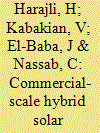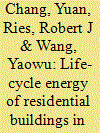|
|
|
Sort Order |
|
|
|
Items / Page
|
|
|
|
|
|
|
| Srl | Item |
| 1 |
ID:
171442


|
|
|
|
|
| Summary/Abstract |
Solar photovoltaic (PV) diesel hybrid systems are effective solutions for sustainable energy transition in countries where utility grids are intermittent. An ‘integrated appraisal’ of 'hybrid solar (PV) - diesel' systems are carried out to assess their overall energetic, environmental, financial and economic performances. The study carries out the analysis of hybridized solar photovoltaic energy using first-hand data and information collected from the Palestinian, Lebanese and Iraqi commercial and/or industrial sectors, adopting several scenarios of tariff and diesel fuel prices, capital costs assumptions, solar PV curtailment, and values for environmental damage adopted from life-cycle impact assessment methods that allow for monetization and are globally valid. Results show that hybrid PV-diesel systems have largely beneficial energy, environmental and economic performances in all three countries, whereas their financial performance are also positive for Palestine and Lebanon, however less promising in Iraq, mainly due Iraq's heavily subsidized electricity tariff. The study concludes with policy recommendations focused on promoting solar PV in the commercial and/or industrial sectors, namely: the gradual phasing-out of fossil fuel subsidies, the effective execution of net-metering, the provision of subsidized sustainable energy loans, and carefully designed energy management systems.
|
|
|
|
|
|
|
|
|
|
|
|
|
|
|
|
| 2 |
ID:
098253


|
|
|
|
|
| Publication |
2010.
|
| Summary/Abstract |
Small and open economic systems like cities face specific challenges for greenhouse gas accounting. They typically import most of their energy requirements as secondary energy products based on conversion processes which caused emissions elsewhere. Emission estimates therefore already require attention not only to direct on-site activities. Moreover, for a comprehensive approach it is suggested to include upstream and downstream processes of connected socioeconomic systems and the indirect life-cycle related emissions of imported and exported goods.
Singapore is used in this longitudinal study as an example of an urban scale economy. Accounts for direct emissions are compared with trade corrected estimates of indirect emissions. Results indicate that direct emissions account for only about 20% of the overall upstream emissions necessary to sustain the input side of the economic production process (domestic emissions plus indirect emissions embodied in imported goods). If indirect emissions embodied in exports are considered and subtracted from the previous figure, the trade corrected accounts for direct and indirect emissions still exceed direct emission accounts, although by less than 40%. Given the increasing trends in world trade and urbanisation, indirect pressures of urban systems should be included in discussions of effective and fair adaptation and mitigation strategies.
|
|
|
|
|
|
|
|
|
|
|
|
|
|
|
|
| 3 |
ID:
098548


|
|
|
|
|
| Publication |
2010.
|
| Summary/Abstract |
Small and open economic systems like cities face specific challenges for greenhouse gas accounting. They typically import most of their energy requirements as secondary energy products based on conversion processes which caused emissions elsewhere. Emission estimates therefore already require attention not only to direct on-site activities. Moreover, for a comprehensive approach it is suggested to include upstream and downstream processes of connected socioeconomic systems and the indirect life-cycle related emissions of imported and exported goods.
Singapore is used in this longitudinal study as an example of an urban scale economy. Accounts for direct emissions are compared with trade corrected estimates of indirect emissions. Results indicate that direct emissions account for only about 20% of the overall upstream emissions necessary to sustain the input side of the economic production process (domestic emissions plus indirect emissions embodied in imported goods). If indirect emissions embodied in exports are considered and subtracted from the previous figure, the trade corrected accounts for direct and indirect emissions still exceed direct emission accounts, although by less than 40%. Given the increasing trends in world trade and urbanisation, indirect pressures of urban systems should be included in discussions of effective and fair adaptation and mitigation strategies.
|
|
|
|
|
|
|
|
|
|
|
|
|
|
|
|
| 4 |
ID:
171524


|
|
|
|
|
| Summary/Abstract |
A widespread implicit assumption is that renewable energy options are approximately low-carbon. However, production and life cycles of such technologies tend to produce CO2 emissions. To minimize life-cycle emissions, one should account for such emissions and implement adequate policies to encourage innovation and adoption of well-performing technologies in this respect. We develop a framework to analyse this issue, grounded in the concepts of ‘energy return on energy invested’ (EROI) and ‘net energy return on carbon invested’ (EROC). Applying these to the main PV technologies and production regions – namely China, EU and USA – displays considerable discrepancies. We conditionally predict the development of average EROI and EROC over time under business-as-usual and low-carbon electricity generation scenarios. A main policy lesson is that without a systemic policy instrument, such as carbon pricing, incentives for low-carbon production of renewable energy options are too weak, which likely will delay a complete transition to a low-carbon economy.
|
|
|
|
|
|
|
|
|
|
|
|
|
|
|
|
| 5 |
ID:
125635


|
|
|
|
|
| Publication |
2013.
|
| Summary/Abstract |
Carbon capture and storage (CCS) is an effective technology for the mitigation of greenhouse gas emissions from large-scale fossil fuel use. Nonetheless, it is not yet commercially viable on a large scale, and its inclusion into countries' energy planning agendas depends on realistic assessments of its emission reduction benefits.
The use of CCS leads to energy penalties resulting from direct consumption of additional energy, and results in indirect CO2 equivalent emissions outside plant boundaries, due to both energy consumption and leakages. Accounting for these emissions allows for an evaluation of the mitigation benefits of CCS.
This study performs a life-cycle assessment (LCA), with and without CCS, for a coal-fired power plant located in Brazil. Findings show that when indirect emissions are taken into account, a plant which captures 90% of its CO2 will have its CO2 equivalent emissions capture potential, based on a global warming potential metric with a 100-year time horizon, reduced to 72%. The advantage of the use of carbon capture towards climate change mitigation is reduced mainly as a result of an increase in CH4 emissions, significant in the coal-mining stage, an effect which is only taken into account when a LCA is performed.
|
|
|
|
|
|
|
|
|
|
|
|
|
|
|
|
| 6 |
ID:
125761


|
|
|
|
|
| Publication |
2013.
|
| Summary/Abstract |
In the context of rapid urbanization and new construction in rural China, residential building energy consumption has the potential to increase with the expected increase in demand. A process-based hybrid life-cycle assessment model is used to quantify the life-cycle energy use for both urban and rural residential buildings in China and determine the energy use characteristics of each life cycle phase. An input-output model for the pre-use phases is based on 2007 Chinese economic benchmark data. A process-based life-cycle assessment model for estimating the operation and demolition phases uses historical energy-intensity data. Results show that operation energy in both urban and rural residential buildings is dominant and varies from 75% to 86% of life cycle energy respectively. Gaps in living standards as well as differences in building structure and materials result in a life-cycle energy intensity of urban residential buildings that is 20% higher than that of rural residential buildings. The life-cycle energy of urban residential buildings is most sensitive to the reduction of operational energy intensity excluding heating energy which depends on both the occupants' energy-saving behavior as well as the performance of the building itself.
|
|
|
|
|
|
|
|
|
|
|
|
|
|
|
|
|
|
|
|
|